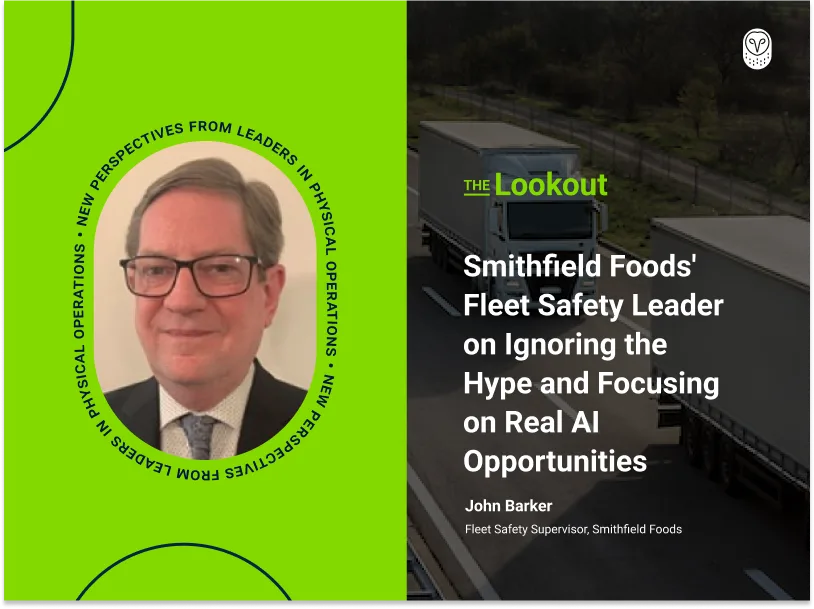Perspectives
Smithfield Foods' Fleet Safety Leader on Ignoring the Hype and Focusing on Real AI Opportunities
April 29, 2024

Fleet Safety Supervisor

This viewpoint is a guest post created by John Barker. Barker is a Fleet Safety Supervisor at Smithfield Foods, one of the largest food processors in the United States. In his current role, he focuses on fleet safety and compliance, and he has more than 30 years of experience managing operations and safety in the logistics industry.
Over the course of my thirty-year career in fleet safety and operations, I've seen a lot of trends and new technologies come and go. However, nothing has seemed to capture our attention like AI. Many experts are busy making predictions about what AI will be able to do in the far-off future, some of which—think super intelligent robots—sounds like pure science fiction.
The hype surrounding AI makes it hard to see the more immediate reality: With the right tools and data, AI can solve real problems for fleets and other types of organizations with physical operations, right here and right now. We've already seen how machines are adept at capturing large amounts of data, recognizing patterns, and surfacing insights that would be difficult, if not impossible, to find on our own.
The problem is AI tools that are being sold as solutions for problems they were never intended to solve. And the stakes can be especially high for fleets and other organizations where safety is a primary concern. Generative AI, for example, is an amazing tool, but it’s not going to help you detect dangerous behavior on the road.
If you're exploring the potential of AI for your organization—or if you feel stuck thinking about where to begin—here are three areas of opportunity where AI can deliver real impact today.
1. AI can help you dig deeper into data and make improvements that matter.
For many people, trucking is simply a matter of getting products from point A to point B. If the delivery is made on time, the customer is satisfied, and everyone is safe, you've done your job. But data can reveal a deeper level, where every aspect of the journey—from the production facility or warehouse to the customer—can be improved. This is where AI can make a huge difference.
In trucking for example, the margins are often slim, and creating a competitive advantage comes from making incremental changes that can drive huge benefits for your organization. In fleet safety, you can see this in changing driver behavior. Lowering speeding incidents by even a few percentage points can significantly reduce accidents, while also reducing incident-related costs.
Even if changes seem small, the information is critical to training AI models to help you make more ongoing improvements even faster and more effectively. It can give you a type of x-ray vision into your data that gives you unique insights into your business—and the market as a whole—that no one else can see.
2. AI can make your safety programs more effective, and help drivers self-coach.
Driving a commercial truck is one of the most high-stakes, complicated jobs you can do. Drivers are inundated with information—weather, traffic patterns, the movements of individual cars, and more—and have to make split-second decisions to stay safe. AI-powered, self-driving trucks can't beat a human when it comes to processing all of this data, and if they ever learn, it won't be for a very, very long time.
What AI can do now is help drivers be safer in the moment and self-coach to make long-term improvements. For example, some AI tools can flag events like distracted driving or speeding and instantly alert drivers in the cab so they can change their behavior.
As tools become more sophisticated and the quality of data improves, AI will help us get a wider view of behavior and be able to detect factors that are risky before they become dangerous. Here again, looking at the data and making changes at the margins has the potential to have a huge impact on making fleets safer.
It’s important, though, to make sure that drivers understand AI is not a “gotcha box.” Transparency and open communication about how AI is being used is essential to gain driver buy-in.
3. AI can optimize the driver experience and make them feel more valued.
As part of my role, I also oversee employee retention, an area that has been a persistent challenge for the trucking industry. In fact, recent turnover rates have risen as high as 60% for some fleet sectors.
AI can play an important role in improving these numbers, but perhaps not in the way you may think. In my experience, drivers aren't necessarily wowed by technology like AI. They just want to do their jobs, do them well, and go home.
Instead, the true impact of AI lies in optimizing the way drivers do their jobs behind the scenes. Take routing, for example: For my team, one big element of driver satisfaction is schedule and route consistency. AI can optimize route assignments and dispatching, helping drivers make deliveries quickly and safely, and allowing them to know when they'll be home at the end of their day. When drivers know they can count on you to respect their time, job satisfaction increases, as does retention.
No one can know exactly what the future will bring, especially when it comes to technology, but one thing is clear: AI is already here, and despite the buzz, is having a real impact on operations like mine. Take advantage of the opportunities that AI presents, and celebrate the discoveries you make along the way.



















